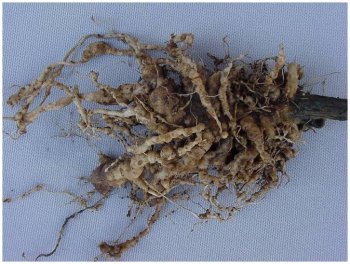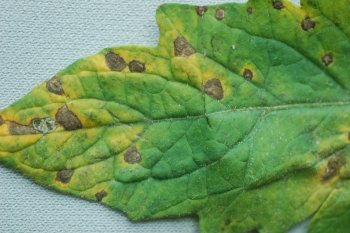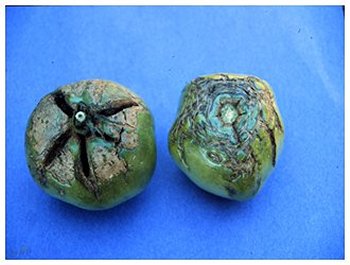Arkansas Grown Tomatoes - Tomato Diseases and Disorders

Browse tomato disease images to help diagnose your tomato symptoms.
It is estimated that of all households who grow vegetables-nationwide, 93% of them have a tomato plant or two-and many have row upon row.
Shade or lack of soil limit the planting of fruits and vegetables, because you do need a minimum of six to eight hours of sunlight a day, to produce healthy tomatoes.
Whether they are shipping out of south Arkansas-(the tomato capital of Arkansas is Bradley and Drew counties), or coming from your local grower at the farmers market, there is a good supply of tomatoes this season.
Commercially Grown Arkansas Tomatoes
Growers in south Arkansas changed from the traditional pink tomato to the red Mountain series in the mid 1980's.
The reason for the change was they needed a product that could be successfully shipped across the country without splitting or breaking apart, and one that would last in your kitchen for more than a day or two. The first of the new generation of Mountain tomato series was Mountain Pride. There have been five different Mountain series tomatoes since, until the current Mountain Spring. This large fruited, blemish-free, tomato, ships beautifully, lasts at room temperature for more than a week, and has good flavor-if you allow it to ripen all the way. These tomatoes average 10- 12 ounces per tomato, and fill up a 20 pound tomato box in no time at all.
Commercial growers in south Arkansas start their season in February, when they plant the seeds.
They usually plant the fields in early April, and begin harvesting, usually by June 10. The way they grow tomatoes has changed a lot in the past ten to twenty years. They now plant on furrowed rows covered in black plastic. This keeps the weeds down, conserves moisture, heats up the soil in the spring, and keeps the soil off the stems. A machine can fumigate the soil, lay the plastic and a drip irrigation tube all at the same time. Then they plant, and off they go.

Watering Tomatoes to Reduce Disease
Drip irrigation keeps water in the row where the root system needs it. No splashing, overhead water keeps the plants dry, and keeps the soil from splashing onto the stems -- a leading cause of disease problems. With the drip system, growers water daily -- once temperatures heat up, and they can also fertilize through their watering system.
Using Lime to Prevent Tomato Disease
Lime is used to avoid blossom end rot, and they lime according to soil test results. Growers will follow up with a high nitrogen fertilizer two or three times during the season, depending on the year.
Determinate and Indeterminate Tomatoes
There are two basic types of tomato plants - determinate and indeterminate-in laymen terms, often referred to as bushy or tall growing plants. Determinate plants are self-topping, and typically form a stronger main stem and have a bushier growth. The top buds set fruits, thus stopping the continuation of growth.
Indeterminate tomatoes continue to grow all season, unless you top them. Plants have grown twelve to fifteen feet or more, and require staking for support. These are often the varieties that home gardeners grow.
Storing and Ripening Tomatoes

For best flavor, store tomatoes at room temperature.
If you buy tomatoes that are not fully ripe, they will continue to ripen on the kitchen counter. If you need them quickly, you can speed up the ripening process by placing tomatoes in a brown paper bag or in a fruit-ripening bowl. Some people do like their tomatoes chilled, but only refrigerate if fully ripe, and then only for a few days. The flavor is better if they aren't chilled. Cut them just as you are planning to use them. (From: Dr Craig Anderson, Extension Horticulture Specialist)
Infectious Tomato Diseases
Most of the infectious (biotic) diseases are caused by different fungal organisms, followed by bacteria, viruses and nematodes. There are a few non-infectious diseases (abiotic) that are directly related to an unfavorable growing environment.
The most important first step in managing the disease is to get an accurate diagnosis. The University of Arkansas Cooperative Extension Service provides disease diagnosis through the Plant Health Clinic located at the Cralley-Warren Laboratory at the AAES in Fayetteville, Arkansas. The clinic maintains an image library that is useful with diagnoses.
Significant Tomato Diseases (Infectious/Biotic)
Bacterial Speck/Bacterial Spot
These two bacterial diseases cause small water soaked leaf spots and fruit lesions. Splashing water and machinery can move the bacteria within a field. Wet cool conditions contribute to these diseases.
Buckeye Rot
This fruit rot disease is caused by a fungus that lives in the soil. Most prevalent in poorly drained soils with warm, wet weather. The fungus can also attack pepper and eggplant. Dark "zonate" bands develop on the infected fruit near the soil.
Early Blight
This fungus disease can produce leafspots, stem lesions and fruit lesions. Leaf spots are more important. The leaf spots often occur with concentric lines that are up to ½ inch in diameter. Spots can sometimes grow together forming larger dead areas. Leaf spots sometimes surrounded by a yellow halo.
Septoria Leaf Spot
Small BB sized black spots that often turn gray. Caused by a fungus. Results in defoliation. Primarily a foliage problem.
Southern Blight
The fungus that causes SB can persist in the soil for years. The disease can also affect other members of the Solanaceae family of plants. Avoid its' introduction into the growing area. Difficult to manage. Often observed in hot weather. Causes a wilting of the plant.
Root-knot Nematode
This nematode caused disease can also be severe on cucurbits, eggplant, lettuce, spinach and many other vegetables. Plants become stunted, unthrifty, and chlorotic. Round swellings (galls) develop on the roots as a result of root feeding by this small round worm. Symptoms more evident during hot/dry weather.
Tomato Spotted Wilt Virus
This is a virus disease. The virus is carried by thrips. Upper leaves wilt and become blackened. Various color distortions such as concentric rings to fruit. The virus can overwinter in weeds. Virus infected plants cannot be cured. This disease is managed by growing resistant varieties.
Fusarium Wilt
Caused by a fungus that is capable of surviving extended periods in the soil. Plants become infected through the roots. Wilt and subsequent death of plant occurs following infection. Reddish-brown internal stem discoloration under the bark is diagnostic.
Significant Tomato Diseases (Non-Infectious/Abiotic)
Cat Face
Fruit malformations and scarring during fruit development. Often associated with cool weather during fruit set.
Fruit Cracking
Moisture fluctuations within the plant can cause splitting of the skin.
Blossom End Rot (BER)
This disorder results from insufficient calcium. It is also often associated with improper soil moisture fluctuations.
Yellow Shoulder
This disorder is associated with exposure to high temperatures during fruit maturation.
Light may manifest the damage. Some cultivars more sensitive than others.
Sun Scald- Fruit clusters become suddenly exposed to intense sunlight. Often observed
in hot dry weather.
Publications
-
MP154 - Arkansas Plant Disease Control Products Guide
An annually revised publication that contains the most recent recommendations for chemical control of plant diseases.
- Managing Tomato Diseases In Arkansas
An overview of the economically important tomato diseases in Arkansas and their management options.